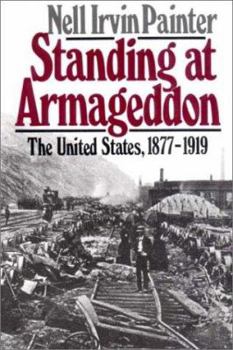Standing at Armageddon: The United States, 1877-1919
Select Format
Select Condition 
Book Overview
Standing at Armageddon is a comprehensive and lively historical account of America's shift from a rural and agrarian society to an urban and industrial society. Nell Irvin Painter will be featured in the PBS multipart series The Progressive Era with Bill Moyers, which coincides with the release of the updated edition of this acclaimed work.
Format:Paperback
Language:English
ISBN:0393305880
ISBN13:9780393305883
Release Date:April 1989
Publisher:W. W. Norton & Company
Length:464 Pages
Weight:1.43 lbs.
Dimensions:1.1" x 6.1" x 9.1"
Customer Reviews
5 ratings
absolutely excellent
Published by Thriftbooks.com User , 14 years ago
I am an historian of modern US history, and I find this one of the best history books I have ever read. It makes so many things that even I did not completely understand extremely readable and understandable, and is not afraid to get into banking history and taxation history and political history and military history. The focus, of course, is working people (black and white, Northern and Southern). Really really amazing.
Interesting reading
Published by Thriftbooks.com User , 15 years ago
If you have to read this book for school don't fret. It is quick and interesting reading!
good history of an ignored era
Published by Thriftbooks.com User , 16 years ago
This is a good general history of a deliberately overlooked period in American history. It is an era of economic turmoil, the failure of reconstruction, social ferment and political corruption. This is mostly not a happy political era, but its an important era to understand in terms of the history of the country. The history of the period is especially important in terms to understanding the reality of American history and the fact that there was no golden age of business-led prosperty at any point in the past. The only flaw of the book is its reach. 1919 is too far. The book should have stopped at the election of Teddy Roosevelt or even the spanish American war breaking out. The progressive era and the world war one era are too much for a book like this to cover. It would have been better with the scope cut back. But all in all a decent book of history.
America's Greatest Hits, 1877-1919
Published by Thriftbooks.com User , 24 years ago
Standing at Armageddon, by Nell Irvin Painter, covers American history from Reconstruction to the end of World War I, outlining American progress many fronts. At different times, it works as pieces of social, political, and economic history. Painter's attention to detail informs the reader with razor-sharp accuracy, but also at times provides too much information, revealing Painter's personal biases. In outlining this period of American history, Painter asserts that America was performing a tight-rope walk on the brink of destruction. America's omnipresent danger of collapse is portrayed through looks at social, economic, and political history, but the three are sometimes interconnected and some are presented more than others. In the mix, reform and inequality are paramount. Painter belabours the plight of women and blacks especially, devoting a chapter to each. Using many resources, Painter explores the aspects of social reform, including comprehensive reports of the working class, and the struggle for reform, this book is easily called social history, perhaps at the expense of political and economic history. Painter discusses the plight of women with especial detail, showing all sides of suffrage and oppression. Her female subjects range from Jane Addams to Emma Goldman, displaying convictions, goals, and accomplishments of each. Her thoughtfulness in this type of integration shows she has a flair for demonstrating societal matters. As a work of political history, SAA is fine. Important acts of legislation and politicians are not left out of the mix, and are integrated well with social aspects. With regard to legislation, no important bill is left out. The book nicely traces the rise and fall of the Civil Rights Act of 1975 and then follows up, discussing the "separate but equal" and Jim Crow laws that followed. Seamlessly, Painter follows up with the effects of said laws on society, furthering this book as a piece of social history. Economic history is present in this book, but is the servant of social and political history. For example, the bimetallism debates of the late 19th-century are explained with regards to society, such as farmers and rural citizens, and politics, such as the international effects of bimetallism, but the book does not speculate on bimetallism itself. The book also discusses economic factions such as the Greenbackers, but does so with regard to the groups themselves, instead of their economic principles. This book is not a work of economic history, but it does effectively integrate it with other subject matters. SAA covered a great many different topics within its time period, but concentrated most heavily on social history. Political history is also used, discussed, and mentioned. However, the economic history as a servant to the other two lessens its value as an independent topic, though it is nonetheless worthwhile. Though Painter tries mightily to cram a lot between the
I LOVE books!
Published by Thriftbooks.com User , 25 years ago
When I was a young boy my father used to read me lots and lots of books as I lay in bed on a cold winters night. I like this one the best.






